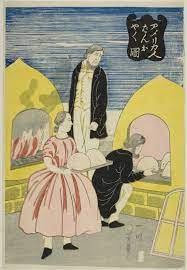Japonism in art is a wave of fascination that rippled through Europe, forever altering the course of Western art.
It’s a story of East meets West, where Japanese aesthetics left an indelible mark on European canvases.
We’ll explore how Japonism infused its distinct style into the works of renowned artists like Van Gogh and Monet.
Buckle up for an artistic journey that reshaped the art world and continues to inspire creativity to this day.
What Is Japonism?
Japonism, a term first coined by French art critic Philippe Burty in 1872, encapsulates the influence of Japanese art on Western culture.
At its core, it represents a fascination and assimilation of Japanese aesthetics into various European art forms.
This cultural phenomenon sprouted in the mid-19th century when Japan ended its era of isolation and began trading with the West.
In the realms of painting, sculpture, and the decorative arts – Western artists were awe-struck by the fresh perspectives brought forth by Japanese creativity.
This was particularly true for the Edo period ukiyo-e woodblock prints, which became vastly popular among European artists and connoisseurs.
- Ukiyo-e featured flat areas of color – Use of strong lines,
- Contrasting compositions,
- An absence of shadow.
plus to visual arts, Japonism left a mark on theater and performance art.
Film, as a nascent art form, also absorbed elements of Japanese storytelling, with its emphasis on simplicity and directness.
Visual motifs and thematic underpinnings from Japanese culture began to permeate screenplays, set designs, and cinematic techniques.
Impressionists like Claude Monet and Post-Impressionists such as Vincent van Gogh avidly collected Japanese prints.
The flat planes, vibrant colors, and striking silhouettes of these prints informed their work and shifted their perspectives on light, shadow, and composition.
Van Gogh’s Starry Night Over the Rhone and Monet’s series of Water Lilies reveal the depth of Japanese influence on their approaches to nature and landscape.
In film, directors have drawn on the compositional techniques and narrative structures unique to Japanese cinema.
The deliberate pacing, minimalist sets, and often poetic interplay between character and environment recall the serene yet profound ambiance of a Japanese woodblock scene.
The Influence Of Japonism On European Art
Japonism infiltrated the tapestry of European creativity, leaving an indelible mark on the visual arts.
The allure of Japanese art’s elegance nourished the innovative spirit of European artists, bestowing upon them a new vocabulary of aesthetics.
- The palette and composition deployed in La Femme au Chapeau by Matisse scream Japonism’s influence,
- The juxtaposition of European figures against a wash of Japanese motifs in Madame Chrysanthème stands as a testament to this cultural infusion.
Artisans, bewitched by the minimalism and sophistication of Japanese prints, forged a union between East and West techniques.
This artistic symbiosis bore fruit in the realms of form, color, and perspective.
- The flattened space and streamlined forms in The Dancing Class embody Degas’s homage to Japanese printmaking,
- Toulouse-Lautrec’s works reimagined Parisian nightlife through the lens of Japanese woodblock designs.
As we jump into the realms of theatre and film, it’s evident that the narrative structures and stage settings owe much to Japonism.
Audiences became captivated by the simplicity that contrasted so sharply with the elaborate backdrops they were accustomed to.
- Greek Tragedy composition captured a stillness reminiscent of Kabuki stages,
- The sharp angularities in German Expressionist films mirror the defining edges commonly found in Ukiyo-e prints.
Each frame, each scene, choreographed with a relentless pursuit of that serene aesthetic, speaks volumes of Japonism’s far-reaching tentacles.
Even as new art movements ascend, the whispers of Japonism resound, ensuring this enchanting dialogue between the Occident and the Orient is everlasting.
In the dance of brush strokes and the interplay of light and shadow, Japonism courted modernity.
The relationship between these distant cultures opened new frontiers for artists who were starving for innovation.
- Van Gogh’s The Starry Night swirls with a rhythm lifted from Japanese nature scenes,
- Whistler’s Nocturne series echoes the ethereal and transient essence of Japanese landscapes.
Our fascination with marrying the disparate continues to yield a rich tapestry of heritage that transcends boundaries.
Through the embracing of Japonism, European art found renewal, gifting the world a legacy of transcultural masterpieces.
Japonism In The Works Of Van Gogh
Vincent van Gogh’s engagement with Japanese art is evident in both his style and subject matter.
His extensive collection of Japanese prints had a profound impact on his work, influencing his use of color and composition.
The Starry Night and Almond Blossoms are prime examples of Van Gogh’s adaptation of Japanese techniques.
These paintings show a clear departure from traditional Western perspectives, embracing a flatter aesthetic and bold contours.
Unique elements of Japonism depicted in these works include:
- Use of vibrant, unblended colors,
- Prominent outlines that add a sense of flatness,
- Nature as a central subject, demonstrating a harmony with the environment.
In a letter to his brother Theo, van Gogh expressed his admiration for Japanese art, stating that it “studied life under all climates and in all times of the day.
” This quote underscores the profound impact Japanese culture had on his artistic vision.
Van Gogh’s Japonaiserie works, such as The Courtesan and Flowering Plum Tree (after Hiroshige), directly imitate the ukiyo-e woodblock print genre.
Within these pieces, the dialogue between two distinct art worlds – East and West – is seamlessly forged.
Through his oeuvre, van Gogh brought the aesthetics of Japanese art to light in Western eyes.
His intense and emotive interpretations are characterized by a vivid palette and dynamic brushwork, elements he saw and embraced in Japanese prints.
Japonism In The Works Of Monet
Exploring the reaches of Japonism, it’s vital to consider the captivating works of Claude Monet.
His encounters with Japanese art notably shifted his artistic trajectory, enabling him to view his European surroundings through an entirely new lens.
Monet’s gardens at Giverny, alive with water lilies and bridges, echo the serene beauty found in Japanese landscapes.
Much like van Gogh, Monet was profoundly influenced by the Japanese approach to nature and composition.
In The Water Lily Pond, the use of asymmetry and a palette comprising subtle color variations can be traced directly back to the aesthetics of ukiyo-e prints.
This fascination with aligning Western painting techniques alongside Japanese aesthetics became a hallmark of Monet’s approach.
In our analysis, we identify several characteristics of Japonism in Monet’s work:
- A preference for everyday life and nature scenes,
- Flat areas of bold color,
- Unconventional use of perspective.
Monet’s interest in Japanese art was not merely a stylistic affectation, but a genuine integration of Eastern philosophies into his work.
The simplicity and elegance found in artworks such as The Japanese Bridge and The Artists Garden at Giverny reflect an internalized understanding of Japanese principles.
Monet’s art, with its transient light effects and reflections, also mirrors the Japanese concept of ‘mono no aware’, the empathetic appreciation of the ephemeral nature of life.
Through our informed perspective, we appreciate how Monet’s art became an avenue through which Japonism filtered into the broader visual arts culture.
Art enthusiasts and filmmakers alike can draw from this melding of East and West, applying these hybrid aesthetics to their own visual storytelling.
Monet’s legacy, infused with the essence of Japonism, offers us timeless principles of beauty and composition.
Japonism’s Legacy In Western Art
Expanding beyond the canvas, Japonism’s influence reached the dynamic realm of the early 20th-century design and architecture.
Architects like Frank Lloyd Wright embraced the simplicity and harmony evoked by Japanese spatial concepts in their work.
Wright’s structures, such as the iconic Fallingwater, resonate with the balance and integration of nature inherent in Japanese design.
The potency of Japonism was not limited to visual arts – it spilled over into the world of performing arts and even fashion.
The Paris Exposition of 1889, which celebrated the technological and cultural achievements of the time, reintroduced Oriental aesthetics to the masses.
Japanese theatrical performances and kimono-clad figures influenced designers who began to incorporate asymmetry, layering, and nature motifs into Western dress.

Our exploration of Japonism reveals its indelible imprint on various art forms:
- Art Nouveau’s curvilinear designs and floral motifs,
- The prismatic fragmentation in Cubism,
- Streamlined forms in Modernist architecture.
Artists continue to reference motifs from Japanese woodblock prints, filtering them through contemporary sensibilities.
In the cinematic arena, directors like Wes Anderson have often attributed their symmetric compositions and stylized color palettes to the aesthetic principles previously seen in Japanese art.
In Anderson’s film The Grand Budapest Hotel, we witness a delightful confluence of Eastern compositional techniques with Western narrative storytelling.
By immersing ourselves in the study of Japonism, we not only acknowledge the enduring partnership between Eastern and Western aesthetics but also develop a profound appreciation for the cultural exchange that enriches our creative landscape.
As we forge ahead, integrating novel technologies and ideas into our artistry, the principles of Japonism remind us to maintain a balance of form, function, and beauty.
What Is Japonism In Art – Wrap Up
We’ve seen how Japonism has woven its intricate patterns through the fabric of Western art, leaving a legacy that continues to inspire and influence.

From Monet’s tranquil gardens to the bold strokes of Modernist architecture, the East-West aesthetic dialogue shapes our cultural landscape.
As we embrace the ephemeral beauty of ‘mono no aware’, we recognize the profound impact of this artistic synergy.
Japonism isn’t just a historical footnote—it’s a living exchange that enriches our creative expression across multiple domains.
Let’s continue to explore and celebrate the cross-cultural currents that define our artistic heritage.
Frequently Asked Questions
How Did Japonism Influence Western Culture?
Japonism notably impacted Western culture by inspiring artists like Vincent van Gogh and Claude Monet, infusing their works with Japanese aesthetic principles such as appreciation for nature, everyday scenes, bold colors, and unique perspectives.
What Effect Did Japanese Art Have On Vincent Van Gogh?
Japanese art profoundly influenced Vincent van Gogh, encouraging him to adopt themes of nature and everyday life, as well as bold color usage and distinctive compositions, which became hallmarks of his iconic style.
How Did Claude Monet’s Artistic Trajectory Change Due To Japonism?
Japanese art inspired Claude Monet to create his famous gardens at Giverny, which reflect Japanese landscape aesthetics and principles.
This influence extended to his paintings, incorporating characteristics like flat color planes and new perspectives.
What Is ‘mono No Aware’, And How Is It Reflected In Monet’s Work?
‘Mono no aware’ is the Japanese concept that expresses a sensitive appreciation for the transient nature of life.
Monet’s work internalizes this philosophy, capturing the ephemeral qualities of the natural world with an empathetic approach.
How Did Japonism Extend Beyond Painting?
Japonism influenced a wide array of Western art forms, including design, architecture, performing arts, fashion, and cinema, leading movements like Art Nouveau and Cubism and contributing to the development of Modernist architecture and contemporary cinema.
What Legacy Did Japonism Leave In Western Art?
Japonism left a lasting legacy in Western art by fostering a cultural exchange that enriched creative expressions and taught timeless principles of beauty and composition, which can still be seen across various art and design disciplines today.


